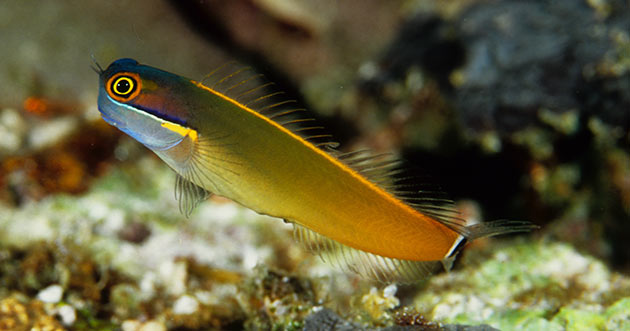
The genus Ecsenius is comprised of approximately 53 small species, many of which are brightly colored or attractively marked. Dr. Victor Springer of the American Museum of Natural History is the authority on the group. In 1988, he named 20 species in the genus and has since named many others. The Clown Blennies are limited in distribution to coral reef ecosystems. In fact, it is one of a few genera of blenniids that is almost always found among stony corals. Most occur in shallow reef habitats (less than 50 feet), like fringing coastal reefs, reef flats, and outer reef faces.
Many of the Ecsenius spp. have very limited distributions. This is probably a function of their being strongly tied to coral reefs and their having a short larval stage. Because of these two factors, populations are more likely to become isolated over time and begin to change from one another as slight genetic differences begin to concentrate since there is no interchange in genetic material between the “mother” population and “satellite” populations (in the case of the Ecsenius spp., these changes to which I refer are usually limited to alterations in the color pattern).
In some cases, speciation may occur and distinct species may be present on different reef tracts separated by a coral-less area of only 50 miles. As ichthyologists investigate more isolated areas of the western Pacific, they are discovering more new Clown Blenny species. In fact, five species of Ecsenius have been described since the year 2000 as a result of such explorations.
Like most other Blennies, the majority of the Ecsenius spp. spend most of their time at rest on hard substrate. When they seek shelter, they usually back into small holes in the reef. They will remain in the holes with only their heads protruding until they are sure “the coast is clear.” Like all Blennies, the members of this genus lack a swim bladder. When they enter the water column, they have to scull frenetically with their pectoral fins to avoid sinking.
The majority of Ecsenius spp. derive the majority of their nutrients by rasping unicellular algae and some detritus from hard substrates. However, at least some species will consume the polyps of small-polyped stony corals. Those that are known to include coral polyps in their natural diets include the Bicolor Blenny (Ecsenius bicolor) and the Red Sea Mimic Blenny (E. gravieri). There are also a few species (e.g., Midas Blenny, Ecsenius midas) that regularly feed on zooplankton.
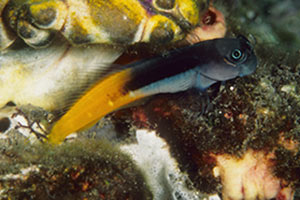
Escenius bicolor |
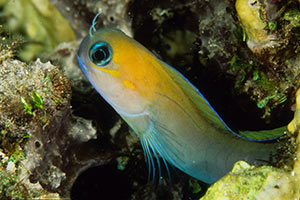
Escenius midas |
Many of the Clown Blennies occur singly and are territorial. There territories can be quite small as it is not uncommon to see several conspecifics on the same coral head or small patch reef. There are at least a few species that do live in small groups (e.g., Ecsenius lividanalis E. ops, and E. tricolor). While fighting is rarely observed in the field, in the confines of the aquarium many of the species will fight. These Blenny battles are ritualized, with serious injuries rarely occurring if space is not to limited. Like most fishes, these Blennies engage in threat displays before they attack conspecifics. If bluffing doesn't cause one individual to back down, fighting ensues. Individuals will bite and ram each other, directing their attacks toward the head and front of the body. Escalated aggression also includes jaw-locking with subsequent wrestling, or swimming in head-to-tail circles.
While seeking shelter in small holes is the most common antipredation tactic employed, there is at least one species that mimics a harmful family member in order to dissuade predators from attempting to eat them. The Red Sea Mimic Blenny mimics the Blackline Fang Blenny (Meiacanthus nigrolineatus). This is an example of Batesian mimicry, that is, when a “non-nasty” species mimics a “nasty one!” The “nasty one” in this case, has venomous fangs that it uses to bite the inside of the mouths of predators that ingest it. Predators quickly learn to avoid the venomous Blenny, and as result, this provides some degree of predatory immunity for the species that mimics it.
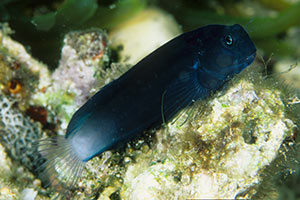
Escenius namiyei |
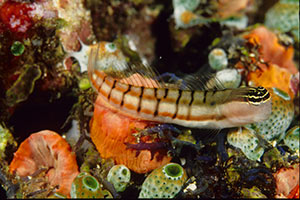
Escenius dilemma |
The Midas Blenny (E. midas) engages in social mimicry. This form of mimicry is often exhibited by solitary fish that swim among social species that form schools or shoals. While there is safety in numbers, an individual that stands out from the school will be more vulnerable to predation than group members of the same species. In order to take advantage of the “dilution of risk” that occurs when living in homogenous groups, some solitary reef fishes adopt or mimic the coloration of the schooling or shoaling species with which they associate.
Such is the case with the Midas Blenny. When it feeds, this solitary species will adopt the color pattern and live within groups of Anthias. In the Line Islands, the livery of the Midas Blenny resembles that of the Bartlett’s Anthias (Pseudanthias bartlettorum), Dispar Anthias (P. dispar), and Whitley’s Slender Anthias (Luzonichthys whitleyi). In the Indian Ocean, there is a purplish-gray color form that appears to mimic Evan’s Anthias (P. evansi). Over much of its range, E. midas mimics and hovers among groups of Lyretail Anthias (Pseudanthias squamipinnis).
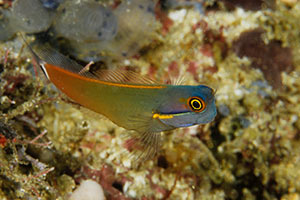
Escenius stigmatura |
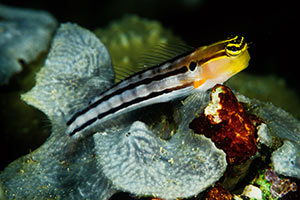
Escenius axelrodi |
The sexuality mode of the Ecsenius blennies has yet to be determined. It is likely that they are protogynous hermaphrodites. In at least some species, males are larger, on average, than females – this type of dimorphism is common in protogynous species. However, further research is required to verify this. In some species (e.g., E bicolor) males may also have more segmented dorsal fin and/or anal fin rays on average than females or have long filaments extending from the caudal fin (e.g., Aron’s Clown Blenny (Ecsenius aroni)). Some species also exhibit sexual differences in the number of incisor teeth.
The Clown Blennies lay demersal eggs in a nest (usually a hole or shell). In at least some species (e.g., E. bicolor) the fish eggs are attached to the sides or roof of a shelter hole by tiny threads that extend from the sides of the eggs. The fish eggs are approximately 0.75 mm long and 0.5 mm high. The male does not tend the fish eggs, until they are ready to hatch, at which time he vigorously fans them with his fins. In E. bicolor, the eggs hatch in nine days when kept at a temperature of 80 degrees Fahrenheit. At hatching, the larvae are 3.5 mm in length.
Part 1:
Introduction |
| |
Part 2:
The Natural History of Clown Blennies |
| |
Part 3:
Keeping Clown Blennies in the Home Aquarium |

Scott Michael
Scott W. Michael is an internationally-recognized writer, underwater photographer, and marine biology researcher specializing in reef fishes, and was the Banquet Speaker at our 2007 and 2008 Coral Conference and Frag Swap. He is a regular contributor to Aquarium Fish Magazine, Freshwater and Marine Aquarium Magazine, SeaScope, and is the author of Reef Fishes Vol 1, Vol 2, and Vol 3, Vol 4, and Vol 5., A Pocket Expert Guide Marine Fishes, A Pocket Expert Guide to Reef Aquarium Fishes, 101 Best Saltwater Fishes: How to Choose and Keep Hardy, Brilliant, Fascinating Species That Will Thrive in Your Home Aquarium, Reef Sharks & Rays of the World, and Aquarium Sharks & Rays. Having studied marine biology at the University of Nebraska, Scott has served as a scientific consultant for National Geographic Explorer, the Discovery Channel, and French educational television.
|